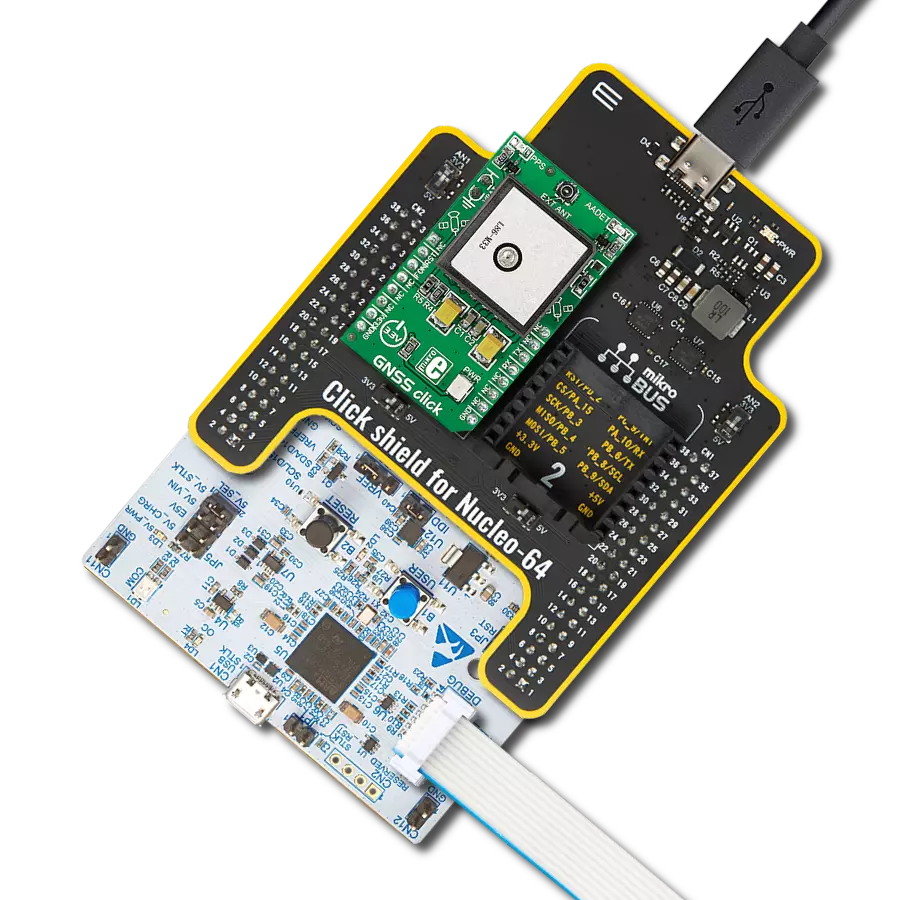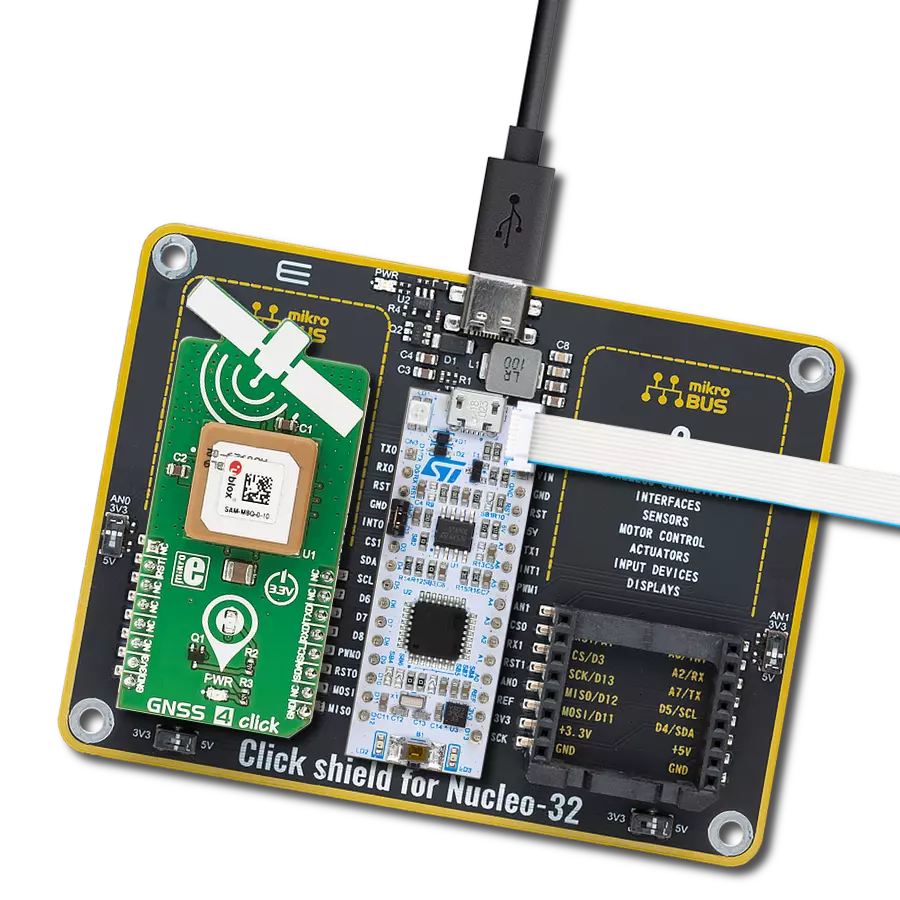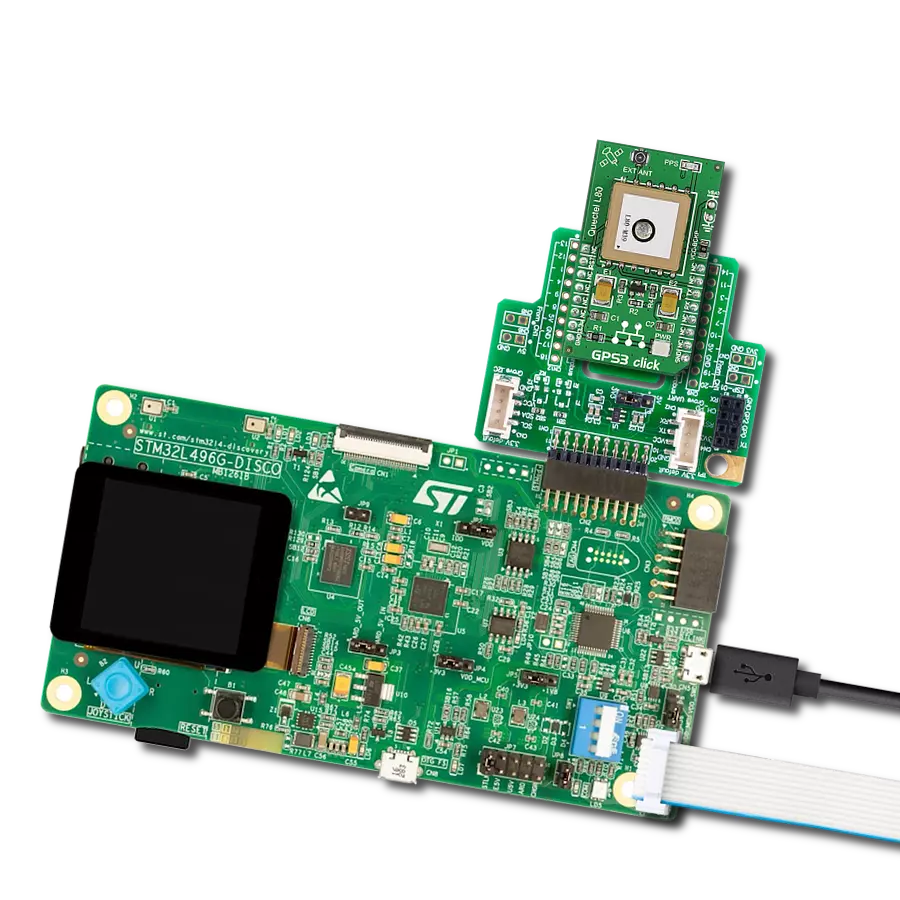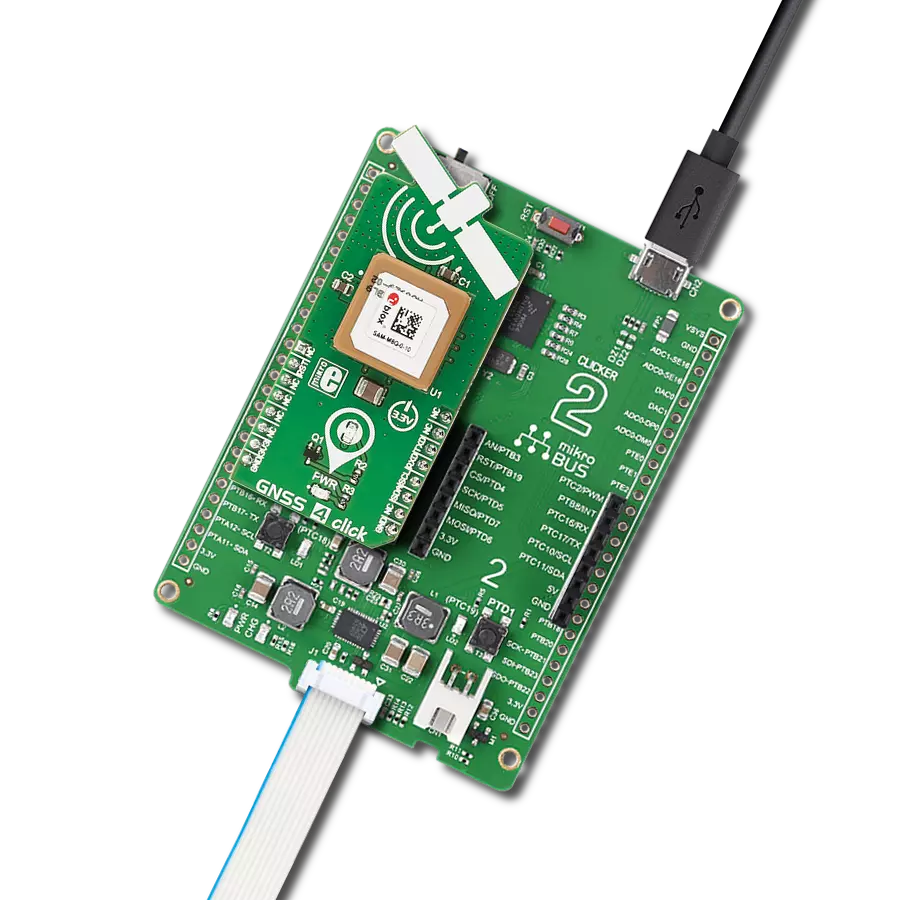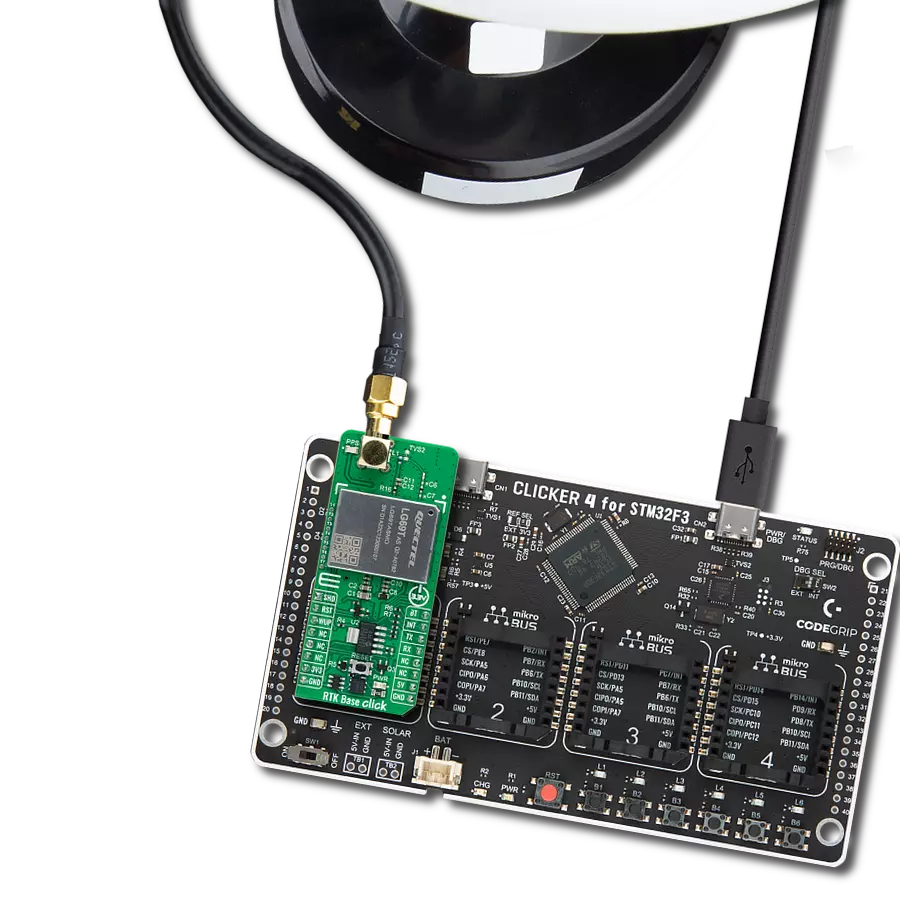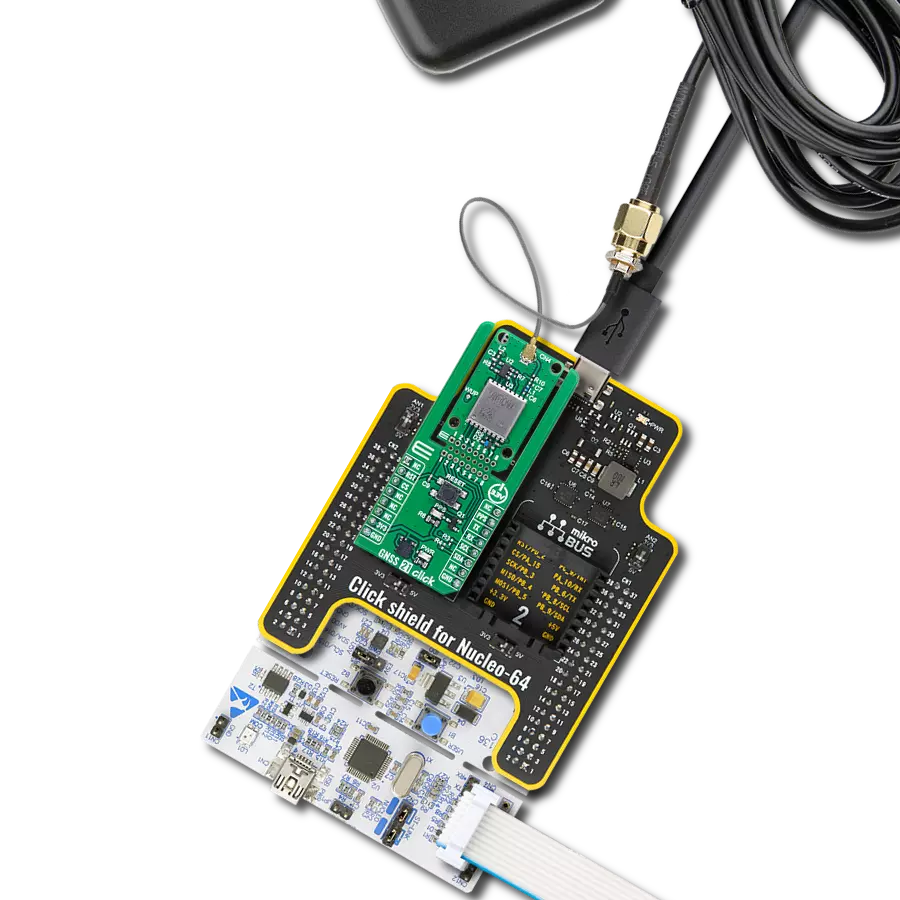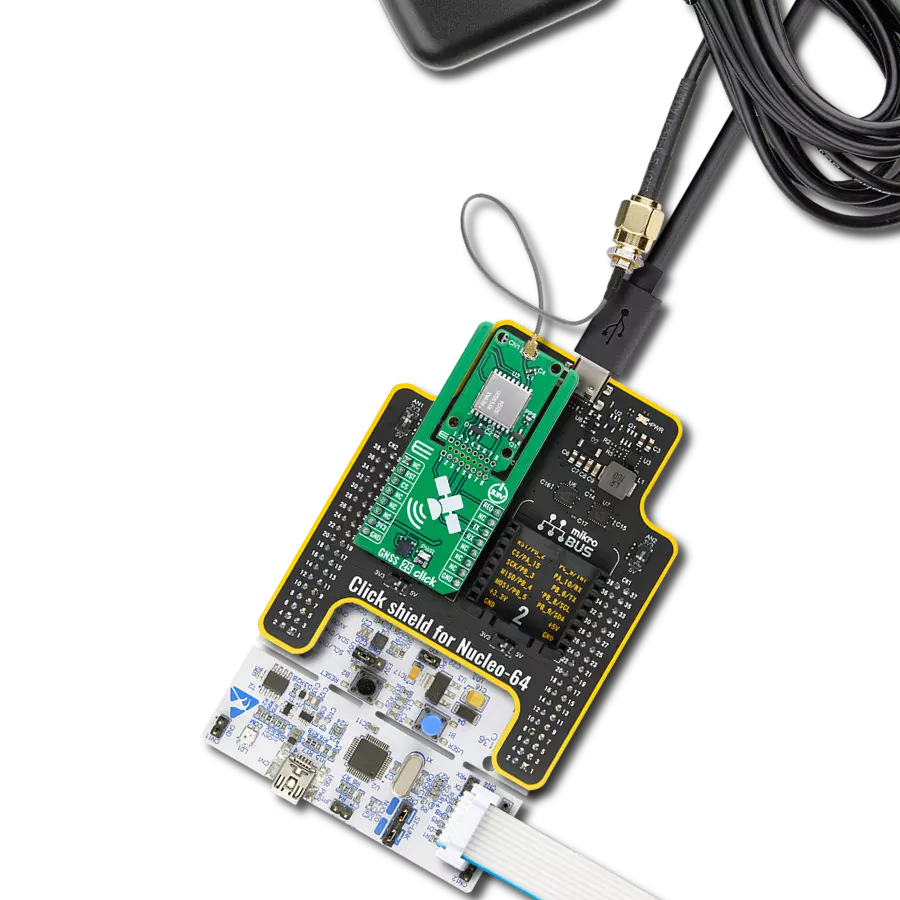Our advanced GNSS solution supports navigation, mapping, and geographic analysis by providing real-time positioning data, enhancing decision-making and productivity
A
A
Hardware Overview
How does it work?
GNSS 3 Click is based on the SIM33ELA module, a standalone or A-GPS receiver with a built-in chip antenna from SIMCom. The SIM33ELA supports only the L1 band with 33 tracking and 99 acquisition channels. The module provides complete signal processing from antenna input to host port in either NMEA messages with the maximum update rate of 10Hz. The module is an ultra-low tracking power consumption device with a high sensitivity of -165dBm while tracking and -147dBm in acquisition mode with fast re-acquisition time. The greater number of visible satellites increases positioning accuracy (<2.5m CEP) and decreases acquisition time (<1.5s TTFF with a warm start). GNSS 3 Click supports anti-jamming, better positioning under weak signal conditions with onboard LNA, and 12 multi-tone active interference cancellers. The SIM33ELA supports EPO (Extended Prediction Orbit) data service that can predict a 7/14/31-day orbit to
customers, with occasional downloads from the EPO server. Information like ephemeris, almanac, rough last position and time, satellite status, and optional time synchronization will reduce TTFF. It can be uploaded to the SIM33ELA module by the host side. EASY (Embedded Assistant System) mode predicts satellite navigation messages from the received ephemeris. The module also supports DGPS SBAS (Satellite Based Augmentation System) and RTCM, where only one mode can be used at a time. The SBAS depends on the user’s continent. The SIM33ELA uses the UART interface with commonly used UART RX and TX pins as its default communication protocol for the host microcontroller. It operates at 115200bps by default configuration to transmit and exchange data. In addition, this Click board™ features other functions accessible through mikroBUS™ signals, such as Reset (RST) for resetting the device and INT pin that could control the module coming
into or waking up from Sleep mode. In addition to the possibility of using the built-in chip antenna, this Click board™ can also use an external active antenna offered by Mikroe, thanks to the onboard n.FL connector and ANT SEL solder jumper set to INT or EXT position. In addition to precise positioning, the GNSS 3 Click also has an accurate timing signal indicated via a red LED indicator marked as PPS, the successful positioning indicated by a yellow LED indicator marked as FIX, and the green PWR LED, which acts as a wake-up indicator. This Click board™ can be operated only with a 3.3V logic voltage level. The board must perform appropriate logic voltage level conversion before using MCUs with different logic levels. Also, it comes equipped with a library containing functions and an example code that can be used as a reference for further development.
Features overview
Development board
Nucleo-64 with STM32F091RC MCU offers a cost-effective and adaptable platform for developers to explore new ideas and prototype their designs. This board harnesses the versatility of the STM32 microcontroller, enabling users to select the optimal balance of performance and power consumption for their projects. It accommodates the STM32 microcontroller in the LQFP64 package and includes essential components such as a user LED, which doubles as an ARDUINO® signal, alongside user and reset push-buttons, and a 32.768kHz crystal oscillator for precise timing operations. Designed with expansion and flexibility in mind, the Nucleo-64 board features an ARDUINO® Uno V3 expansion connector and ST morpho extension pin
headers, granting complete access to the STM32's I/Os for comprehensive project integration. Power supply options are adaptable, supporting ST-LINK USB VBUS or external power sources, ensuring adaptability in various development environments. The board also has an on-board ST-LINK debugger/programmer with USB re-enumeration capability, simplifying the programming and debugging process. Moreover, the board is designed to simplify advanced development with its external SMPS for efficient Vcore logic supply, support for USB Device full speed or USB SNK/UFP full speed, and built-in cryptographic features, enhancing both the power efficiency and security of projects. Additional connectivity is
provided through dedicated connectors for external SMPS experimentation, a USB connector for the ST-LINK, and a MIPI® debug connector, expanding the possibilities for hardware interfacing and experimentation. Developers will find extensive support through comprehensive free software libraries and examples, courtesy of the STM32Cube MCU Package. This, combined with compatibility with a wide array of Integrated Development Environments (IDEs), including IAR Embedded Workbench®, MDK-ARM, and STM32CubeIDE, ensures a smooth and efficient development experience, allowing users to fully leverage the capabilities of the Nucleo-64 board in their projects.
Microcontroller Overview
MCU Card / MCU

Architecture
ARM Cortex-M0
MCU Memory (KB)
256
Silicon Vendor
STMicroelectronics
Pin count
64
RAM (Bytes)
32768
You complete me!
Accessories
Click Shield for Nucleo-64 comes equipped with two proprietary mikroBUS™ sockets, allowing all the Click board™ devices to be interfaced with the STM32 Nucleo-64 board with no effort. This way, Mikroe allows its users to add any functionality from our ever-growing range of Click boards™, such as WiFi, GSM, GPS, Bluetooth, ZigBee, environmental sensors, LEDs, speech recognition, motor control, movement sensors, and many more. More than 1537 Click boards™, which can be stacked and integrated, are at your disposal. The STM32 Nucleo-64 boards are based on the microcontrollers in 64-pin packages, a 32-bit MCU with an ARM Cortex M4 processor operating at 84MHz, 512Kb Flash, and 96KB SRAM, divided into two regions where the top section represents the ST-Link/V2 debugger and programmer while the bottom section of the board is an actual development board. These boards are controlled and powered conveniently through a USB connection to program and efficiently debug the Nucleo-64 board out of the box, with an additional USB cable connected to the USB mini port on the board. Most of the STM32 microcontroller pins are brought to the IO pins on the left and right edge of the board, which are then connected to two existing mikroBUS™ sockets. This Click Shield also has several switches that perform functions such as selecting the logic levels of analog signals on mikroBUS™ sockets and selecting logic voltage levels of the mikroBUS™ sockets themselves. Besides, the user is offered the possibility of using any Click board™ with the help of existing bidirectional level-shifting voltage translators, regardless of whether the Click board™ operates at a 3.3V or 5V logic voltage level. Once you connect the STM32 Nucleo-64 board with our Click Shield for Nucleo-64, you can access hundreds of Click boards™, working with 3.3V or 5V logic voltage levels.
Used MCU Pins
mikroBUS™ mapper
Take a closer look
Click board™ Schematic

Step by step
Project assembly
Track your results in real time
Application Output
1. Application Output - In Debug mode, the 'Application Output' window enables real-time data monitoring, offering direct insight into execution results. Ensure proper data display by configuring the environment correctly using the provided tutorial.

2. UART Terminal - Use the UART Terminal to monitor data transmission via a USB to UART converter, allowing direct communication between the Click board™ and your development system. Configure the baud rate and other serial settings according to your project's requirements to ensure proper functionality. For step-by-step setup instructions, refer to the provided tutorial.

3. Plot Output - The Plot feature offers a powerful way to visualize real-time sensor data, enabling trend analysis, debugging, and comparison of multiple data points. To set it up correctly, follow the provided tutorial, which includes a step-by-step example of using the Plot feature to display Click board™ readings. To use the Plot feature in your code, use the function: plot(*insert_graph_name*, variable_name);. This is a general format, and it is up to the user to replace 'insert_graph_name' with the actual graph name and 'variable_name' with the parameter to be displayed.

Software Support
Library Description
This library contains API for GNSS 3 Click driver.
Key functions:
gnss3_parse_gngga- GNSS 3 parse GNGGA functiongnss3_generic_read- Generic read functiongnss3_module_wakeup- Wake-up module.
Open Source
Code example
The complete application code and a ready-to-use project are available through the NECTO Studio Package Manager for direct installation in the NECTO Studio. The application code can also be found on the MIKROE GitHub account.
/*!
* \file
* \brief Gnss3 Click example
*
* # Description
* This example demonstrates the use of GNSS 3 Click by reading and displaying
* the GPS coordinates.
*
* The demo application is composed of two sections :
*
* ## Application Init
* Initializes the driver and resets the Click board.
*
* ## Application Task
* Reads the received data, parses the GNGGA info from it, and once it receives the position fix
* it will start displaying the coordinates on the USB UART.
*
* ## Additional Function
* - static void gnss3_clear_app_buf ( void )
* - static err_t gnss3_process ( gnss3_t *ctx )
* - static void gnss3_parser_application ( char *rsp )
*
* @note
* The default baud rate for communication UART is set to 9600. If you receive
* a Click board on which the default baud rate for UART is set differently,
* you will need to change the setting in the gnss13_setup_cfg function.
*
* \author MikroE Team
*
*/
// ------------------------------------------------------------------- INCLUDES
#include "board.h"
#include "log.h"
#include "gnss3.h"
#define PROCESS_BUFFER_SIZE 200
static gnss3_t gnss3;
static log_t logger;
static char app_buf[ PROCESS_BUFFER_SIZE ] = { 0 };
static int32_t app_buf_len = 0;
static int32_t app_buf_cnt = 0;
/**
* @brief GNSS 3 clearing application buffer.
* @details This function clears memory of application buffer and reset its length and counter.
* @return None.
* @note None.
*/
static void gnss3_clear_app_buf ( void );
/**
* @brief GNSS 3 data reading function.
* @details This function reads data from device and concatenates data to application buffer.
* @param[in] ctx : Click context object.
* See #gnss3_t object definition for detailed explanation.
* @return @li @c 0 - Read some data.
* @li @c -1 - Nothing is read or Application buffer overflow.
* See #err_t definition for detailed explanation.
* @note None.
*/
static err_t gnss3_process ( gnss3_t *ctx );
/**
* @brief GNSS 3 parser application.
* @param[in] rsp Response buffer.
* @details This function logs GNSS data on the USB UART.
* @return None.
* @note None.
*/
static void gnss3_parser_application ( char *rsp );
void application_init ( void )
{
log_cfg_t log_cfg;
gnss3_cfg_t cfg;
/**
* Logger initialization.
* Default baud rate: 115200
* Default log level: LOG_LEVEL_DEBUG
* @note If USB_UART_RX and USB_UART_TX
* are defined as HAL_PIN_NC, you will
* need to define them manually for log to work.
* See @b LOG_MAP_USB_UART macro definition for detailed explanation.
*/
LOG_MAP_USB_UART( log_cfg );
log_init( &logger, &log_cfg );
log_info( &logger, "---- Application Init ----" );
// Click initialization.
gnss3_cfg_setup( &cfg );
GNSS3_MAP_MIKROBUS( cfg, MIKROBUS_1 );
gnss3_init( &gnss3, &cfg );
gnss3_module_wakeup( &gnss3 );
Delay_ms ( 1000 );
}
void application_task ( void )
{
gnss3_process( &gnss3 );
if ( app_buf_len > ( sizeof ( ( char * ) GNSS3_RSP_GNGGA ) + GNSS3_GNGGA_ELEMENT_SIZE ) )
{
gnss3_parser_application( app_buf );
}
}
int main ( void )
{
/* Do not remove this line or clock might not be set correctly. */
#ifdef PREINIT_SUPPORTED
preinit();
#endif
application_init( );
for ( ; ; )
{
application_task( );
}
return 0;
}
static void gnss3_clear_app_buf ( void )
{
memset( app_buf, 0, app_buf_len );
app_buf_len = 0;
app_buf_cnt = 0;
}
static err_t gnss3_process ( gnss3_t *ctx )
{
int32_t rx_size = 0;
char rx_buf[ PROCESS_BUFFER_SIZE ] = { 0 };
rx_size = gnss3_generic_read( ctx, rx_buf, PROCESS_BUFFER_SIZE );
if ( rx_size > 0 )
{
int32_t buf_cnt = 0;
if ( ( app_buf_len + rx_size ) > PROCESS_BUFFER_SIZE )
{
gnss3_clear_app_buf( );
return GNSS3_ERROR;
}
else
{
buf_cnt = app_buf_len;
app_buf_len += rx_size;
}
for ( int32_t rx_cnt = 0; rx_cnt < rx_size; rx_cnt++ )
{
if ( rx_buf[ rx_cnt ] )
{
app_buf[ ( buf_cnt + rx_cnt ) ] = rx_buf[ rx_cnt ];
}
else
{
app_buf_len--;
buf_cnt--;
}
}
return GNSS3_OK;
}
return GNSS3_ERROR;
}
static void gnss3_parser_application ( char *rsp )
{
char element_buf[ 100 ] = { 0 };
if ( GNSS3_OK == gnss3_parse_gngga( rsp, GNSS3_GNGGA_LATITUDE, element_buf ) )
{
static uint8_t wait_for_fix_cnt = 0;
if ( strlen( element_buf ) > 0 )
{
log_printf( &logger, "\r\n Latitude: %.2s degrees, %s minutes \r\n", element_buf, &element_buf[ 2 ] );
gnss3_parse_gngga( rsp, GNSS3_GNGGA_LONGITUDE, element_buf );
log_printf( &logger, " Longitude: %.3s degrees, %s minutes \r\n", element_buf, &element_buf[ 3 ] );
memset( element_buf, 0, sizeof( element_buf ) );
gnss3_parse_gngga( rsp, GNSS3_GNGGA_ALTITUDE, element_buf );
log_printf( &logger, " Altitude: %s m \r\n", element_buf );
wait_for_fix_cnt = 0;
}
else
{
if ( wait_for_fix_cnt % 5 == 0 )
{
log_printf( &logger, " Waiting for the position fix...\r\n\n" );
wait_for_fix_cnt = 0;
}
wait_for_fix_cnt++;
}
gnss3_clear_app_buf( );
}
}
// ------------------------------------------------------------------------ END
Additional Support
Resources
Category:GPS/GNSS


















